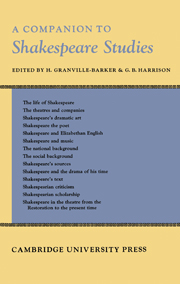Book contents
- Frontmatter
- Contents
- ILLUSTRATIONS
- Preface
- The Life of Shakespeare
- The Theatres and Companies
- Shakespeare's Dramatic Art
- Shakespeare the Poet
- Shakespeare and Elizabethan English
- Shakespeare and Music
- The National Background
- The Social Background
- Shakespeare's Sources
- Shakespeare and the Drama of his Time
- Shakespeare's Text
- Shakespearian Criticism
- Shakespearian Scholarship
- Shakespeare in the Theatre from the Restoration to the Present Time
- Reading List
- Appendices
- Index
- Plate section
Shakespeare and Music
Published online by Cambridge University Press: 05 August 2012
- Frontmatter
- Contents
- ILLUSTRATIONS
- Preface
- The Life of Shakespeare
- The Theatres and Companies
- Shakespeare's Dramatic Art
- Shakespeare the Poet
- Shakespeare and Elizabethan English
- Shakespeare and Music
- The National Background
- The Social Background
- Shakespeare's Sources
- Shakespeare and the Drama of his Time
- Shakespeare's Text
- Shakespearian Criticism
- Shakespearian Scholarship
- Shakespeare in the Theatre from the Restoration to the Present Time
- Reading List
- Appendices
- Index
- Plate section
Summary
The age of Shakespeare was one in which music, both in England and in other countries, reached an extraordinarily high artistic level. Not merely is it an age of great composers all over Europe, but it is an age in which music was widely cultivated and appreciated. In mediaeval days music had been centred mainly in the courts of princes, in the cathedrals and the monasteries. Outside these environments domestic life had been neither secure nor comfortable enough to permit of any serious and continuous cultivation of the art by ordinary people. The English, it is true, had always been a music-loving nation since the twelfth century, if not before; but in days when no music was printed and comparatively little written down, musical education apart from professional circles (in which we can include both the wandering minstrels and the church musicians) must have been very irregular. During the whole of the fifteenth century there was a very large production of ecclesiastical music, but our records of secular music during that period are of the scantiest. Church music was written down and preserved for regular use; secular music, composed for the entertainment of people who had few books and comparatively little occasion for either reading or writing, was learned largely by ear. There was no reason to preserve it in writing; when audiences were tired of one song or dance musicians were always ready to provide new ones.
- Type
- Chapter
- Information
- Companion to Shakespeare Studies , pp. 137 - 162Publisher: Cambridge University PressPrint publication year: 1934
- 1
- Cited by



